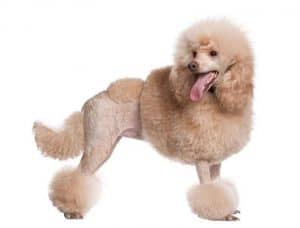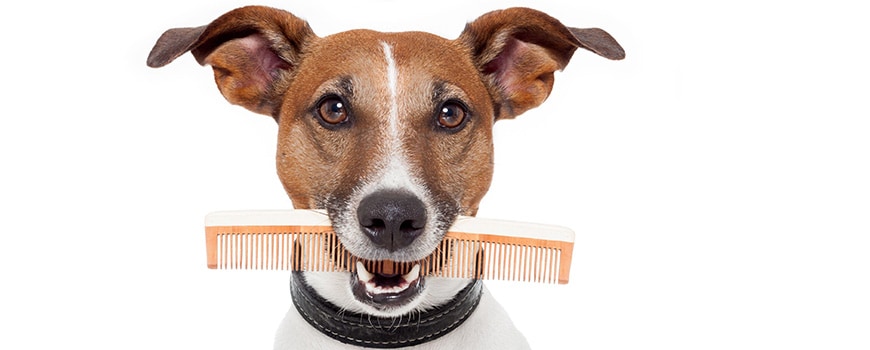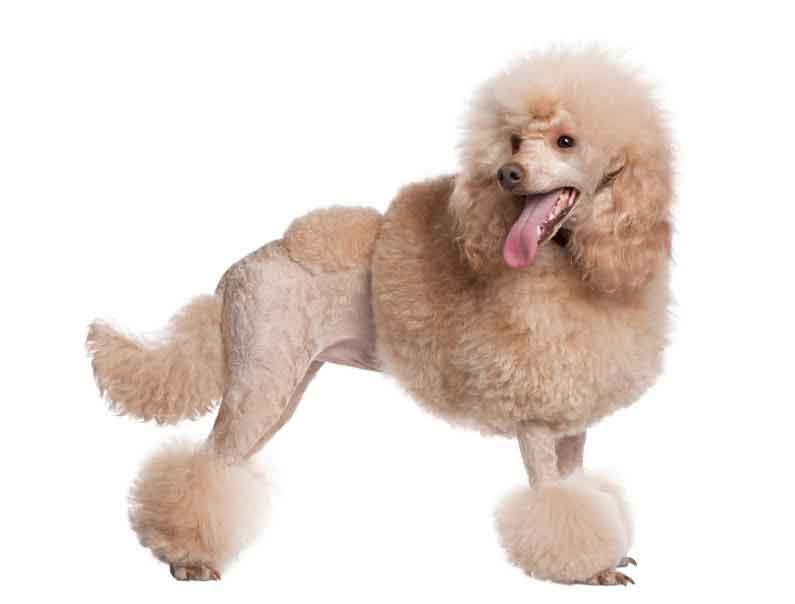If you are new to Poodle grooming and have never attempted the Continental clip, here is a little advice. Although the basic pattern for this clip is the same for all Poodle varieties, the placement of the lines and the finishing touches depend on the proportions of each individual Poodle.
Here are the steps to follow for the Continental clip:
- Bathe the Poodle and blow dry the hair straight.
- Follow instructions for clipping the feet. Clip to the end of the foot; not up on the ankles. While the Standard states that the entire shaven foot should be visible, until you master the trim you desire, it’s better to leave the clipped line lower rather than to take too much off.
- Follow instructions for clipping the face. On the sides of the head, be sure the clipped line is straight between the outer corner of the eye to the ear. This automatically sets the topknot line on each side.
- Clip the tail and shape the pompon. On all the show clips, you want to leave as much hair as possible to shape into a pompon. A good rule is to clip about one-quarter of the tail and leave the hair on the remaining three-quarters to be shaped into the pompon. Stand your dog on the grooming table with its hindquarters facing you. Grasp the end of the tail in your free hand. Starting on the upper side, place your clippers flat against the skin and clip in to the tail’s juncture with the body. Clip the sides of the tail in the same manner. The underside of the tail is a very sensitive area, and should be clipped in the opposite direction, or from the body out to the pompon.
The clipped line around the tail must be even or the pompon won’t look properly shaped. Hold the tip of the tail in your free hand and fluff the hair out with a comb. Use curved shears to shape the pompon very full and round. - Place the Poodle in a sitting position facing you to clip the throat. It is trimmed into a V shape. Start at a point in the middle of the throat, a little below the Adam’s Apple, and clip each side of the neck up to the front of each ear. Because this is a sensitive area, if your Poodle clipper burns easily, set the V in the opposite direction, by starting at the base of the ear and clipping downward to the middle of the throat. Adjust the V upward or downward, depending on the length of your Poodle’s neck.
- Stand the Poodle on the grooming table. The first step in the Continental clip is to make a part completely around the dog behind the last rib with a knitting needle or the tip of a rat-tail comb. The hair in front of the part, the mane or ruff, will remain long. The hair behind the part, on the hindquarters, will be shaved off except for two rosettes over the hipbones. It’s tricky to explain exactly where on the dog’s body to part the hair. It should be separated where it keeps the dog in balance, and this spot varies with the individual dog. Try making the part 1/2 inch in back of the last rib on a Toy Poodle, about 1 inch in back of the last rib on a Miniature, and about 1.5 to 2 inches in back of the last rib on a Standard. Then step back and look at the dog. If he appears out of balance, move the part forward or backward. It’s often necessary to experiment a little until the dog looks balanced and pleasing to the eye. Once the part is made, brush the hair in front of the part upward. To protect it and keep it out of the way while you shave the hindquarters, especially if you are a beginner, push the long hair forward and spray it with some hair spray, or wrap a wide strip of VetWrap around the back and under the chest.
- The hindquarters are clipped close, with a bracelet on each back leg and a rosette (optional) above each hip. Begin pattern work by shaving the back legs. Pointing clippers upward, begin about 1/2 inch above the hock joint on a Toy or Miniature Poodle and about 1 inch on a Standard, and clip up to the hindquarters. To emphasize angulation, slant the clipped line slightly downward at the front of the leg. Remove all the hair on the outside and inside of the back leg. Clip the opposite leg.
- Clip the stomach. Pointing clippers upward, start just above the testicles or vulva, and clip to the part line near the middle of the dog.
- The next step is to clip a rosette on each side of the hindquarters. Depending on the variety of the Poodle you are clipping, rosettes should be spaced about 1/4 to 1 inch apart and placed immediately over the middle of the hipbone. If the Poodle you are clipping has a less-than-ideal tail-set, however, you will want to move the rosettes slightly backward. If the topline is slightly roached or arched, move the rosettes slightly forward, keeping less distance between them and the mane. If the dog is a little long in body, place the rosettes higher on the hips, make them slightly larger in size and keep each front edge close to the mane.
- Begin by clipping a narrow strip (about the same width as the base of the tail) from the base of the tail straight up the backbone, stopping at the line of the mane. To correctly proportion the width of the strip, use a #5/8 blade on a Toy Poodle, a #7/8 blade on a Miniature Poodle, and a #40 on a Standard. Be sure the dog stands straight. If he is fidgety, have someone steady his front so the strip is not off-center. The size of the rosettes should fit the dog. Generally on a Toy
 Poodle the rosettes are about 1.5 inches in diameter; on a Miniature Poodle, they are about 2.5 to 3 inches in diameter; and on a Standard, from 3.5 to 4 inches in diameter. They can be increased or decreased in size in accordance with the dog’s conformation. Clipping round rosettes freehand and making them even in size, shape and placement is rather difficult. Most professionals use an object as a template or guide: a plastic cup or jar, an aerosol can lid, or anything nonbreakable with an opening the diameter of the desired width. Hold the template against the hair and trim around the edges with scissors. Once you have made two basically round shapes, then trim around them with clippers.
Poodle the rosettes are about 1.5 inches in diameter; on a Miniature Poodle, they are about 2.5 to 3 inches in diameter; and on a Standard, from 3.5 to 4 inches in diameter. They can be increased or decreased in size in accordance with the dog’s conformation. Clipping round rosettes freehand and making them even in size, shape and placement is rather difficult. Most professionals use an object as a template or guide: a plastic cup or jar, an aerosol can lid, or anything nonbreakable with an opening the diameter of the desired width. Hold the template against the hair and trim around the edges with scissors. Once you have made two basically round shapes, then trim around them with clippers. - With the #40 blade, clip the remaining hair around each rosette up to the part line near the middle of the dog.
- Comb each rosette upward and outward to lift the hair as much as possible. Scissor around each one to emphasize its round shape, then shape the top to look slightly domed. Trim the basic round outline first, working in a circular motion and taking off a little hair at a time. Once you have the correct shape, the rosettes can be refined. Although they should be slightly domed on top, you want to keep them fairly low in height. Rosettes that are too high will create the illusion that the dog is high in the rear and that his neck is short. Both rosettes must be even in size and shape.
- If rosettes are not desired, shave the hindquarters up to the part line.
- Comb the hair below the hock joint on each back leg. Begin shaping the bracelet by combing the hair down, then scissoring around the clipped line around the foot, to remove any untidy ends. If the dog’s feet are less than ideal, leave a little more hair at the bottom of the bracelet for camouflage. Then comb the hair up, and scissor off any untidy hairs above the clipped line around the leg. Comb the hair outward, then shape each bracelet with curved shears. When viewed from the side, each bracelet is more oval than round in shape, sloping downward from the back of the leg towards the front, emphasizing angulation. When viewed from the back, the bracelets should make the legs appear straight and parallel.
There are several different ways to camouflage subtle faults here. If the dog is a little wide in the rear, leave more hair on the insides of the bracelets and less hair on the outsides. If the dog is slightly narrow behind, do the opposite, leaving more hair on the outsides of the bracelets and less hair on the insides. If the hocks tend to turn in (causing the feet to turn out), build up the hair on the outside and shorten the hair on the inside as you shape each bracelet. If the hocks turn out (causing the feet to turn in), do the reverse. If the hocks are slightly bent or curved and not straight up and down, lengthen the hair at the bottom of each rosette to make the hocks appear straight. Under these circumstances, you might want to forget about the Continental clip entirely and choose the English Saddle clip instead. - Turn the Poodle around to stand facing you to clip the puffs on the forelegs, which should be in balance with those on the hocks. Begin at a point level with the rear bracelets, and clip the front and sides of each foreleg up to the point of the elbow. To take off the hair evenly, clip the back side of each foreleg in the opposite direction, from the point of the elbow down to the top of the puff. If you are a beginner and unsure of where to begin clipping, stand the dog the way you will pose him in the ring. Then scissor a little mark in the hair (even with the rear bracelets).
- Comb the hair on each front puff. Comb the hair down, and scissor around the foot to remove any straggly hairs that fall below the clipped line. As you did on the rear, if the dog doesn’t have great feet, leave a little more hair at the bottom for camouflage. Then comb the hair up, and scissor off any untidy hairs above the clipped line around the leg. Fluff out the hair with a comb, then shape the puffs with curved shears. They are more rounded in shape than the bracelets on the back legs, tapering slightly at the bottom. The puffs on the front legs and the bracelets on the rear legs should be in proportion to each other, and create the illusion that the legs and feet are straight and parallel when viewed from the front or the back of the dog.
- Stand the Poodle on the grooming table in the manner you will pose him in the ring. Comb the mane outward for its final scissoring. The mane should be shaped into a round ball. The length of the mane varies with the individual dog. You can make shaping easier by the way you prepare the long hair. Begin by combing it upward and outward around the neck. As your hand moves backward, comb the hair upward and slightly forward toward the head. Comb the sides of the body outward and slightly forward. Comb the hair on the chest outward and downward, and on the underbody downward and forward. As you scissor and shape the mane, think of circles and balls. Essentially you want to draw a circle, but you’re doing it with shears. Use curved or straight shears. Hold the blades flat against the hair, and don’t point the tips into the coat. Most professionals find it easier to shape the mane round by starting underneath and scissoring upward. Trim the hair around and under the elbow fairly short and tight. You don’t want excess hair in this area to dangle or flip out while the dog is moving around the ring. When you reach the front of the chest, shape it round and tight. An excessive amount of hair here will make the dog look dumpy and long-bodied. If your Poodle has a straight front, however, be careful here. Taking off too much hair will call attention to this fault! You also want to lift each ear and trim the mane a little shorter underneath to make the ears lie flat against the body coat.
- Put up the topknot. If the topknot is too long, it may be scissored shorter to create a better balance to the mane and to frame the head.
- Brush and comb the ear feathering downward. Trim off any uneven ends with your shears, if necessary.
The Finished Product
Your goal is a Poodle that is elegant and proud looking. Everything should be balanced and fit perfectly together in harmony with the breed Standard: the tail with the topknot, the front puffs with the back bracelets, the rosettes balanced in size and shape and not too high, the topknot framing the face and blending into a mane of correct length.
Don’t get carried away with excessive coat. An extravagant amount of hair may seem glamorous, but too much can make a Poodle appear coarse and thickset, the exact opposite of the elegant looking dog described in the breed Standard.

